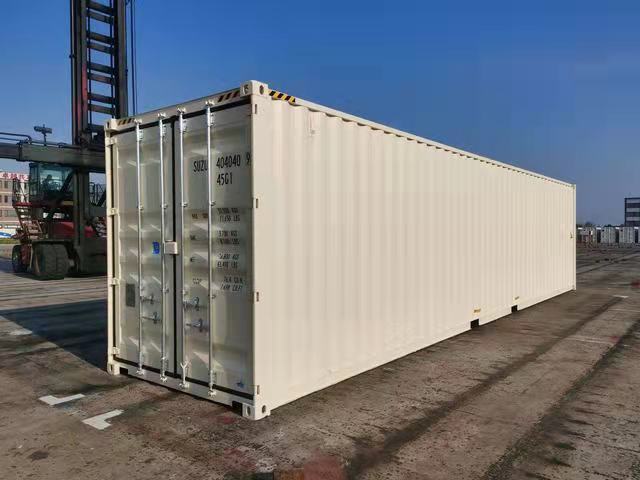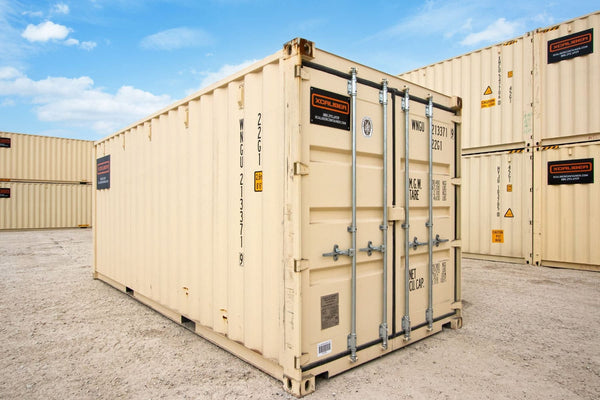Step-by-Step Process to Lease New Shipping Container 40 x 8 x 9.6 for Storage Solutions
Step-by-Step Process to Lease New Shipping Container 40 x 8 x 9.6 for Storage Solutions
Blog Article
The Ultimate Guide to Picking the Right Delivery Container for Your Needs
When it pertains to choosing the best delivery container, understanding your details needs is crucial. You'll want to think about aspects like dimension, type, and product to ensure you make the most effective selection. From common sizes to specialized choices, there's a great deal to check out. And also, budgeting for both the container and any alterations can make a big distinction. Allow's break down the essential elements to assist you find the best fit for your demands.
Recognizing Shipping Container Sizes
When you're choosing a shipping container, understanding the numerous dimensions offered is crucial for making the right choice. Shipping containers generally can be found in typical sizes of 20 and 40 feet, yet you'll also discover other measurements. Knowing the size you need depends upon what you prepare to shop or transport.If you're relocating smaller sized items, a 20-foot container could be optimal, while bigger deliveries commonly need a 40-foot container. Maintain in mind that the height can additionally vary; high cube containers use added upright space, which can be beneficial for taller goods - Rent New Shipping Container 40' x 8' x 9’6".Before determining, gauge your cargo, and think about exactly how much area you'll require for loading and dumping. Constantly element in possible future requirements-- choosing for a somewhat bigger container might conserve you trouble down the line. Ultimately, picking the best dimension will boost performance and assure your items are protected during transportation
Types of Shipping Containers Available
There are several kinds of shipping containers readily available, each designed for particular purposes and freight requirements. The typical dry container is functional, excellent for general freight. If you're delivering subject to spoiling items, take into consideration a refrigerated container, which preserves a controlled temperature. For oversized items, high cube containers use extra elevation, accommodating taller loads.If you require to transport hefty machinery or devices, flat shelf containers give a tough base without walls. Open-top containers enable for simple loading of tall freight, with a removable tarpaulin covering for security. If you're trying to find adaptability, consider a collapsible container that can be easily kept when not in use.Lastly, specialized containers like storage tank containers are used for liquids, while vented containers are created for bulk cargo that requires ventilation. Understanding your freight kind will certainly help you choose the best container to satisfy your shipping requires effectively.
Product Considerations for Longevity
When choosing a shipping container, the product plays an important role in its sturdiness. You'll intend to weigh the advantages of steel versus aluminum, especially pertaining to corrosion resistance. Understanding these variables can help you make a more informed option for your shipping requires.
Steel vs. Light weight aluminum Containers
Exactly how do you pick between steel and light weight aluminum containers for your shipping needs? Begin by considering sturdiness. Steel containers are durable and offer exceptional stamina, making them excellent for heavy tons and severe problems. They withstand damage from effects and are often more economical, which can be a significant element for budget-conscious buyers.On the other hand, light weight aluminum containers are lightweight, which can conserve you on delivery expenses. They're easier to navigate and are a great option if you need to carry goods regularly. Aluminum is typically extra costly and much less robust than steel. Weigh your details requirements very carefully, consisting of weight, cost, and the kind of freight you'll be delivery, to make the ideal selection for your circumstance.
Deterioration Resistance Aspects
Picking the ideal material doesn't just involve weight and expense; corrosion resistance plays a considerable duty in sturdiness. When choosing a shipping container, consider the atmosphere it'll deal with. Steel containers, while solid, can corrosion otherwise properly dealt with. Seek alternatives with protective finishings or galvanization to enhance their lifespan. Aluminum, on the various other hand, offers natural deterioration resistance, making it suitable for seaside areas or humid problems. It can be extra pricey. Additionally, analyze the container's usage-- if it'll be exposed to chemicals or harsh weather, prioritize products that can withstand these problems. Purchasing a corrosion-resistant container currently can save you from pricey fixings or substitutes down the line. Choose intelligently for lasting benefits.
Adjustments and Customization Options
Delivering containers aren't just for delivering goods; they can be changed to satisfy your certain demands with various alterations and modification options. You can convert a conventional container into a relaxing workplace, a short-lived retail shop, or even a personal health club. The possibilities are nearly endless.Think regarding adding home windows, insulation, or ventilation to boost convenience. You could also consider electric circuitry, pipes, and even customized shelving to improve capability. If security's a problem, strengthened locks can give peace of mind.For aesthetic charm, you can paint the container or include an one-of-a-kind style to make it stand apart. Do not neglect about flooring choices-- whether you desire resilient plywood or something extra innovative, it can boost the space.Ultimately, customizing your delivery container to match your requirements can boost functionality and produce an one-of-a-kind environment that mirrors your design.
Evaluating Your Transportation Demands
When it comes to using your changed shipping container, understanding your transport requires is essential. Beginning by determining what you'll be delivery-- whether it's heavy devices, retail items, or individual items. Each kind of freight has different requirements concerning dimension, weight, and accessibility.Next, think about the distance and mode of transportation. Are you delivering locally, nationally, or internationally? This affects the container's layout and performance. If you're making use of trucks, ensure your container fits basic dimensions for easy loading and unloading.Additionally, think of transit problems. Will your items require unique protection from weather or temperature find level variations? If so, you could need insulation or ventilation attributes in your container.Lastly, analyze exactly how typically you'll be transporting items. Constant shipments may call for a more long lasting and versatile container to satisfy ongoing demands. By resolving these aspects, you'll be well-prepared to choose the appropriate shipping container for your needs.
Budgeting for Your Delivery Container
Establishing a budget plan for your shipping container is necessary for ensuring a smooth buying process. Figure out how much you can pay for to spend. Bear in mind that rates can differ significantly based on dimension, condition, and type. New containers generally cost extra, but made use of ones can use significant savings.Next, consider any type of additional costs you might incur, such as transportation fees, distribution fees, and alterations. If you prepare to personalize the container, consider those expenditures as well. Research study different distributors to compare costs and locate the most effective offer that meets your needs.Don' t neglect to consist of any kind of authorizations or regulations that may relate to your purchase and usage of the container. By clearly detailing your budget, you'll be much better prepared to make enlightened choices, ensuring you obtain the right container without damaging the financial institution.
Maintenance and Take Care Of Long life
To guarantee your shipping container lasts for several years, routine maintenance is key. Beginning by evaluating the exterior for corrosion, damages, and damage. If you identify any kind of issues, resolve them immediately to avoid more wear and tear. Clean the container regularly, both in and out, to get rid of dirt, debris, and moisture that can bring about corrosion.Ensure the doors secure appropriately and lubricate the joints to stay clear of rust and sticking. If you're using the container for storage, think about adding air flow to decrease humidity and mold and mildew development. For additional protection, use a rust-inhibiting paint or sealant annually.If your container's located in a severe setting, like coastal areas, you could need to boost upkeep regularity. Watch on the floor covering, also; any type of signs of wear need to be repaired right away. With these basic steps, you'll navigate here expand the life of your delivery container considerably.
Frequently Asked Concerns
Exactly how Do I Discover a Reliable Delivery Container Provider?
To discover a trustworthy delivery container distributor, begin by researching online evaluations, requesting recommendations from pals or sector contacts, and contrasting rates. Constantly check their credentials and warranty they provide top quality containers that satisfy your needs.

Can I Rental Fee a Delivery Container Instead of Acquiring?
Yes, you can absolutely rent a shipping container rather than acquiring one. Lots of vendors provide rental options, which can conserve you money and supply flexibility if you just require it for a brief duration.
What Allows Are Required for Container Placement?

Are Delivery Containers Weatherproof and Suitable for Outdoor Storage Space?
Yes, shipping containers are usually weatherproof, developed to withstand severe problems. Their durable building keeps your things secure and completely dry, making them ideal for outside storage space. Simply guarantee proper air flow to avoid moisture accumulation inside.
Exactly how Do I Move a Delivery Container When Acquired?

Report this page